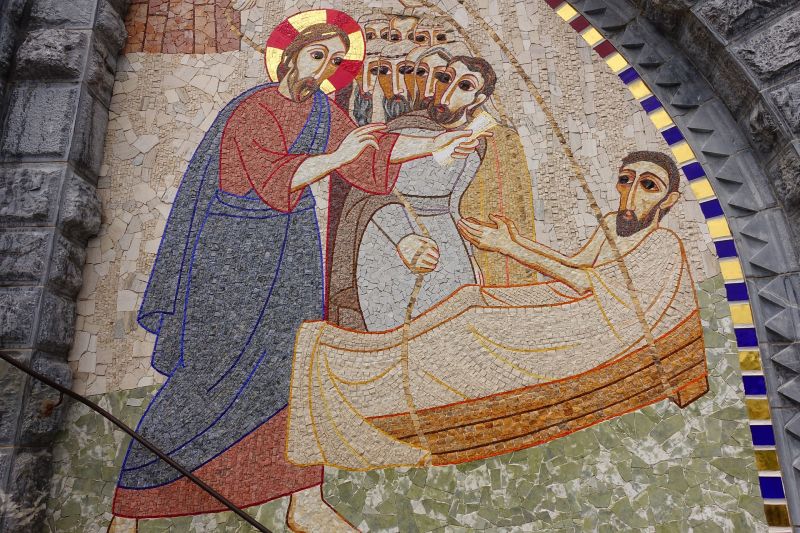
Munich, Germany, Feb 14, 2020 / 04:13 pm (CNA).- Archbishop Paul Gallagher, Secretary for Relations with States of the Holy See, met Friday with Wang Yi, the Chinese foreign minister, discussing their states’ 2018 agreement on episcopal appointments.
The Feb. 14 meeting took place in Munich on the sidelines of the Munich Security Conference.
“In the course of the colloquy, which took place in a cordial atmosphere, the contacts between the two parties were evoked, which have developed positively over time,” according to a Holy See press office communique.
“In particular, there was highlighted the importance of the Provisional Accord on the nomination of bishops, signed 22 September 2018, renewing the willingness to continue the institutional dialogue at the bilateral level to promote the life of the Catholic Church and the good of the Chinese people,” the Holy See press office wrote.
The press office also said that “appreciation was expressed for the efforts being made to eradicate the coronavirus epidemic as well as solidarity with the affected population.”
The Vatican has sent between 600,000 to 700,000 face masks to three provinces in China since Jan. 27 to help contain the spread of coronavirus, and Pope Francis prayed for those infected during his Jan. 26 Angelus prayer.
The press office communique closed saying that “a desire for greater international cooperation to end of promoting civil coexistence and peace in the world was called for, and considerations on intercultural dialogue and human rights were exchanged.”
The Church in mainland China has been divided for some 60 years between the underground Church, which is persecuted and whose episcopal appointments are frequently not acknowledged by Chinese authorities, and the Chinese Patriotic Catholic Association, a government-sanctioned organization.
The September 2018 agreement between the Holy See and Beijing was intended to normalize the situation of China’s Catholics and unify the underground Church and the CPCA. The agreement has been roundly criticized by human rights groups and some Church leaders, including Cardinal Joseph Zen Ze-kiun, Bishop Emeritus of Hong Kong.
Cardinal Zen told CNA Feb. 11 that “the situation is very bad” in China, and added that “the bad things come from [Parolin].”
Cardinal Pietro Parolin is Vatican Secretary of State, and Archbishop Gallagher is one of his top deputies.
According to Cardinal Zen, Cardinal Parolin is so optimistic about the so-called ‘Ostpolitik’, the compromise.”
But, the cardinal told CNA, “you cannot compromise” with the Chinese Communist Party, whom he called “persecutors” of the faith.
“They want complete surrender. That’s communism.”
“More and more, the Church [is] under persecution,” Cardinal Zen said, “both the official Church, and the underground.”
Guidance from the Vatican recognizes the choice of those who feel that they cannot in good conscience register with the government and accept sinicization. However, reports indicate that those who decline to register are facing harassment and persecution.
A report by the Congressional China Commission, issued in January, noted that human rights abuses intensified in China during the 2019 reporting year, and the persecution of Catholics worsened after the Vatican-China deal was reached.
“After the PRC Ministry of Foreign Affairs signed an agreement with the Holy See in September 2018 paving the way for unifying the state-sanctioned and underground Catholic communities, local Chinese authorities subjected Catholic believers in China to increasing persecution by demolishing churches, removing crosses, and continuing to detain underground clergy” the report read.
In December 2019 Bishop John Fang Xingyao of Linyi, president of the CPCA, said that “love for the homeland must be greater than the love for the Church and the law of the country is above canon law.” He was speaking at a Beijing meeting sponsored by the Chinese Communist Party.
New restrictions on religious groups in China went into effect Feb. 1. These include a mandate to implement socialst values, spread the principles of the Chinese Communist Party and support its leaders, and adhere to the path of Chinese socialism.
Religious freedom is officially guaranteed by the Chinese constitution, but religious groups must register with the government, and are overseen by the Chinese Communist Party. The Sinizication of religion has been pushed by President Xi Jinping, who took power in 2013 and who has strengthened government oversight of religious activities.
In 2017, Xi said that religions not sufficiently conformed to communist ideals pose a threat to the country’s government, and therefore must become more “Chinese-oriented.” Since he took power, crosses have been removed from an estimated 1,500 church buildings.
And a government official who oversees religious affairs said in April 2018 that government restrictions on bishop appointments are not a violation of religious freedom, as he emphasized that religions in China must “adapt to socialist society.” The official, Chen Zongrong, added that “I believe there is no religion in human society that transcends nations.”
Restrictions put in place in February 2018 made it illegal for anyone under age 18 to enter a church building.
Muslims, too, have come under pressure from the Chinese government. It is believed that as many as 1 million Uyghurs, a Muslim ethnoreligious group in China’s far west, are being detained in re-education camps where they are reportedly subjected to forced labor, torture, and political indoctrination.
 […]
[…]






Leave a Reply